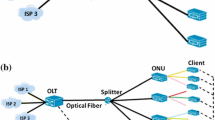Abstract
In this article, a new dynamic bandwidth allocation algorithm for the upstream channel of Ethernet Passive Optical Networks, called DySLa, is proposed not only to provide service differentiation but also to offer subscriber differentiation. In contrast to previous methods in which the performance of each class of service is not insured, DySLa is continuously evaluating the mean packet delay and guarantees that the highest priority services fulfil the packet delay requirements in the access network for every type of client. Simulation results show that DySLa can maintain both the mean packet delay and packet loss ratio below the maximum upper bounds permitted for the most sensitive services of every class of customer. Moreover, DySLa outperforms other dynamic bandwidth allocation algorithms which provide service and client differentiation and it makes a fairer bandwidth distribution than those methods.
Similar content being viewed by others
References
Kramer, G., Mukherjee, B., Maislos, A.: Ethernet passive optical networks. In: Dixit, S. (ed.) Multiprotocol Over DWDM: Building the Next Generation Optical Internet, pp. 229–275, Wiley (2003)
Pesavento M., Kelsey A.: PONs for the broadband local loop. Lightwave 16(10), 68–74 (1999)
Lung B.: PON architecture futureproofs FTTH. Lightwave 16(10), 104–107 (1999)
Kramer G., Mukherjee B., Pesavento G.: Ethernet PON (ePON): design and analysis of an optical access network. Photon. Netw. Commun. 3(3), 307–319 (2001) doi:10.1023/A:1011463617631
Luo Y., Ansari N.: Bandwidth allocation for multiservice access on EPONs. IEEE Commun. Mag. 43(2), 16–21 (2005) doi:10.1109/MCOM.2005.1561907
Byun H.-J., Nho J.-M., Lim J.-T.: Dynamic bandwidth allocation algorithm in ethernet passive optical networks. Electron. Lett. 39(13), 1001–1002 (2003) doi:10.1049/el:20030635
Sherif S.R., Hadjiantonis A., Ellinas G., Assi C., Ali M.: A novel decentralized Ethernet-Based PON Access Architecture for Provisioning Differentiated QoS, IEEE/OSA. J. Lightw. Technol. 22(11), 2483–2497 (2004) doi:10.1109/JLT.2004.836757
Choi S., Huh J.: Dynamic bandwidth allocation algorithm for multimedia services over ethernet PONs. ETRI J. 24(6), 465–468 (2002)
Assi C., Ye Y., Dixit S., Ali M.A.: Dynamic bandwidth allocation for quality-of-service over Ethernet PONs. IEEE J. Sel. Areas Commun. 21(9), 1467–1477 (2003) doi:10.1109/JSAC.2003.818837
Chang C.-H., Kourtessis P., Senior J.M.: GPON service level agreement based dynamic bandwidth assignment protocol. Electron. Lett. 42(20), 1173–1174 (2006) doi:10.1049/el:20062326
Kramer G., Mukherjee B., Pesavento G.: IPACT: a dynamic protocol for an Ethernet PON (EPON). IEEE Commun. Mag. 40(2), 74–80 (2002) doi:10.1109/35.983911
Kramer G., Mukherjee B., Ye Y., Dixit S., Hirth R.: Supporting differentiated classes of service in Ethernet passive optical networks. J. Opt. Netw. 1(8), 280–298 (2002)
Kramer G., Mukherjee B., Pesavento G.: Interleaved Polling with Adaptive Cycle Time (IPACT): a dynamic bandwidth distribution scheme in an optical access network. Photon. Netw. Commun. 4(1), 89–107 (2002) doi:10.1023/A:1012959023043
Banerjee A., Kramer G., Mukherjee B.: Fair sharing using dual service-level agreements to achieve open access in an Ethernet Passive Optical Network (EPON). IEEE J. Sel. Areas Commun. 24(8), 32–43 (2006)
Ma, M., Zhu, Y., Cheng, T.-H.: A bandwidth guaranteed polling MAC protocol for ethernet passive optical networks. In: Proceedings of the Twenty Second Annual Joint Conference of the IEEE Computer and Communications Societies (INFOCOM 2003). 1, 22–31, San Francisco, 2003
Kim, H., Park, H., Kang, D.-K., Kim, C., Yoo, G.-Y.: Sliding cycle time-based MAC protocol for service level agreeable Ethernet Passive Optical Network. In: Proceedings of the IEEE Conference on Communications (ICC 2005). 3, 1848–1852, Seoul, Korea, 2005
Nowak, D., Perry, P., Murphy, J.: A novel service level agreement based algorithm for differentiated services enabled Ethernet PONs. In: Proceedings of the 3rd International Conference on Optical Internet (COIN 2004). 3, 598–599, Japan, 2004
Opnet Modeler Technologies. http://www.opnet.com. Accessed 10 May 2008
Kramer, G.: How efficient is EPON? White paper analyzing various constituents of EPON transmission overhead. Accessed 20 February 2007 (2002)
IEEE.802.3ah Ethernet in the First File Task Force, IEEE 802.3ah Ethernet in the First File Task Force home page. http://www.ieee802.org/3/efm/public/. Accessed 20 June 2007
ITU-T Recommendation G.1010, End-user multimedia QoS categories, Telecommunication Standardization Sector of ITU (2001). http://www.itu.int/rec/T-REC-G.1010-200111-I/en. Accessed 15 January 2008
ITU-T Recommendation G.114, One-way transmission time, in Series G: Transmission Systems and Media, Digital Systems and Networks, Telecommunication Standardization Sector of ITU (2000). http://www.itu.int/rec/T-REC-G.114-200305-I/en. Accessed 15 January 2008
Author information
Authors and Affiliations
Corresponding author
Rights and permissions
About this article
Cite this article
Merayo, N., Durán, R.J., Fernández, P. et al. EPON bandwidth allocation algorithm based on automatic weight adaptation to provide client and service differentiation. Photon Netw Commun 17, 119–128 (2009). https://doi.org/10.1007/s11107-008-0147-9
Received:
Accepted:
Published:
Issue Date:
DOI: https://doi.org/10.1007/s11107-008-0147-9




